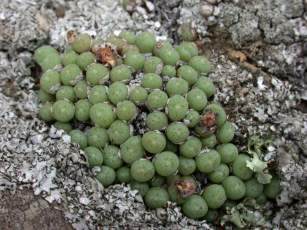Conophytum truncatum
Conophytum truncatum (Thunb.) N.E.Br.
Family: Aizoaceae
Common names: dumpling
Introduction
Have you ever seen anything like this? For the uninitiated this strange plant must seem extraterrestrial. So it must have appeared also to its discoverers in 1791. Little 'dumplings' crammed in between rock crevices growing like a green mat, all seemingly struggling for a bit of sunlight and space! Why do they do it? These strange plants, unique essentially to South Africa, are little known — even to South Africans!

Description
Description
Conophytums are about the most reduced plants in existence. They consist of one pair of fused succulent leaves that get absorbed and regenerated every year. They have a very rudimentary filamentous root system, no stem to speak of, and the ability to produce one, sometimes two, small flowers a year! Some species only form one or two heads, whereas C. truncatum forms huge mounds of sometimes many hundreds of heads. It is very variable in form, colour and markings, ranging from small (4-5 mm in diam.) to large (25 mm in diam.!); from completely unmarked specimens to very heavily spotted or lined, and from bright green to grey-green to having a heavy reddish coloration all often within a single population! The small flowers are nocturnal and typically white or yellow in colour.

Distribution and habitat
Distribution description
Conophytums are distributed throughout the winter-rainfall areas of South Africa (the three Cape provinces) and the southern parts of Namibia. Conophytum truncatum, however, has its centre of abundance in the Little Karoo stretching from the Steytlerville-Springbokvlakte in the east to the Montagu area in the west and is reluctant to venture beyond the confines of the Langeberg in the north and the Swartberg/ Outeniqua Ranges in the south. There are two subspecies: C. truncatum subsp. truncatum, which occupies the eastern part of the range; and C. truncatum subsp. viridicatum, which occupies the western part.
Derivation of name and historical aspects
History
Conophytum literally means cone-shaped, and the specific epithet truncatum refers to its truncated nature — very reduced, fused leaves with a flattened top. To its first discoverers, in 1791, this fundamental feature of the genus must have seemed a peculiar characteristic. Conophytum truncatum was the first member of the genus to be described and was originally called Mesembryanthemum truncatum by Carl Thunberg.
Ecology
Ecology
This species tends to form big tight mounds of heads that secure themselves in rock crevices, known as obligate rock dwellers, where they don't have to compete with other plants for water, space and light. They are generally found growing on east-, south- or west-facing rocky outcrops, very seldom north-facing (too hot). They are not fussy in terms of their geological preferences and can be found growing on shale or quartzite. They are often found growing in amongst mosses and lichens and other shade lovers. Their flowers are pollinated by nocturnal moths that are attracted by a very faint scent, while during the day the flowers close.

Growing Conophytum truncatum
Grow
This species is very easy to grow and very rewarding to the novice and advanced grower alike. They bulk up quickly and will outgrow the pot if not kept in check. They enjoy being grown in either plastic or clay pots (dries out more quickly) with good drainage holes. The soil medium should be essentially mineral with very little organic matter — decomposed rock (granite/sandstone etc.) is best with both fine and coarse particles.
They can be grown in full sun in winter but in the summer months they should be shaded to protect them from drying out.
The drainage should be fairly good but should retain the moisture well as watering needs to happen only about once a week in winter. In summer the plants go dormant by covering themselves in a shell —the shriveled up leaves of the previous year. During summer they should not be watered at all as this might stimulate them into a new flush of growth, which is not a good idea in the baking heat. Misting the plants with a spray-can using rainwater is a good idea in summer as it keeps the plants from dehydrating. This can be done even more frequently in winter when they are actively growing.
Conophytums can be very easily propagated from seed and cuttings, which means that one never has to remove whole plants from the wild. Seeds can be sown in autumn thinly on the soil surface with a thin layer of fine grit covering them. Keep them moist and use a fungicide to prevent them from damping off. Cuttings can be taken anytime during the growing season; no rooting hormones are necessary.
References
- Hammer, S. 1993. The genus Conophytum. Succulent Plant Publications, Pretoria
Credits
Adam Harrower
Kirstenbosch National Botanical Garden
March 2003
Plant Attributes:
Plant Type: Succulent
SA Distribution: Western Cape
Soil type:
Flowering season:
PH:
Flower colour: White, Yellow
Aspect: Full Sun, Shade
Gardening skill: Easy
Special Features:
Horticultural zones








Rate this article
Article well written and informative
Rate this plant
Is this an interesting plant?
Login to add your Comment
Back to topNot registered yet? Click here to register.